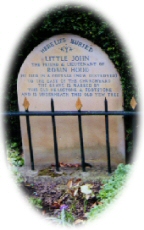The Legend of “Little John”An account by Rosemary Lockie, © Copyright 1999-2006
“You know, there's been a heap of legends and tall tales about Robin Hood.
All different too. Well, we folks of the animal kingdom have our own version.
It's the story of what really happened in Sherwood Forest.”
[Alan-A-Dale (a rooster), in the Disney version of ‘Robin Hood’] q.v. Internet Movie Database Little John, friend and companion to Robin Hood is said to have been born in Hathersage, in the 13th century. The legend claims he was a Nailer, in other words made nails for a living - traditionally a profession requiring a great deal of strength. According to one tradition, he and Robin of Loxley fought at the Battle of Evesham in 1265 for Simon de Montefort. Montefort was defeated, and when his followers were put to flight, they became outlaws - thus the legend of ‘Robin Hood and Little John’ was born. Robin Hood himself supposedly died aged 80, and was buried by Little John at Kirklees Priory in Yorkshire.[1] Little John returned to Hathersage to die, expiring his last breath, it is said, in the cottage where he was born. The cottage was demolished in the latter part of the 19th century, but the site of his grave is marked by a modern tombstone, and may still be seen in Hathersage Churchyard - (see the photograph on the left) Legend has it that he chose this spot himself with an arrow shot from “Robin Hood's Stoop”, a landmark some miles away, on the moorlands above Hathersage. It was recorded in 1652 that his longbow and cap were still to be found hanging up in the Church. Excavation of the burial site in 1784 revealed a thirteen and a half feet long grave, and a thigh bone almost 30 inches long, giving an estimated height of about eight feet. During the late 18th, or early 19th century the cap and longbow were taken by a member of the Shuttleworth family to Cannon Hall at Cawthorne[2] , near Barnsley in Yorkshire, and when the Hall became a museum about 30 years ago, they were temporarily on display. At this time Leeds University Engineering Department tested the bow, which was 6 feet 6 inches long, and came up with the surprising result that the bow would require a pull of at least 600 pounds. Whilst this might not mean much to the average layman, we understand that experienced archers today can pull around 180 pounds on average, whereas the old longbow-men were expected to pull 220 pounds, so if the bow is authentic, it could have been mastered only by one of truly incredible strength![3] Recent research however suggests another provenance for the bow and cap - as symbols of office, belonging to the Eyre family. And the legend of Robin Hood and his Merry Men, rather than being set in the 13th century, may be more appropriately associated with the ‘Coterel Gang’, for whom there is substantial documentary evidence. During the latter years of the reign of Edward II (1320 to 1333), there was sustained looting and pillage in the Midlands by this one gang. One member was named ‘John (the) Little’, and a clergyman Robert Bernard, one-time vicar of Bakewell could have been a real life ‘Friar Tuck’, providing them with sanctuary. [4] Nevertheless, one cannot discount the possibility of there being a very real story behind the Hathersage legend. A ‘local boy made good’ (or bad, depending on your viewpoint) - one or more lads from Hathersage joining up with the local militia to join Simon de Montefort at Evesham, full of hopes of victory, only to have it dashed; it was then all too common for those on the losing side to find themselves outlawed - literally ‘outside’ the law. But their story may have lived on in the village, passed down by word of mouth, and what better way to explain the provenance of newly-discovered artifacts, when in the late 18th century, a burgeoning exuberance for archaeology was unmatched by a comparatively rigorous scientific skepticism? But who am I to discount the Sherwood Forest Legend? It is nevertheless a “Ripping Yarn” - so I offer this account in the spirit of the Disney version of Robin Hood - “how it is, how it was, or (more likely) how it might have been...”[5] (Commentary provided by Rosemary Lockie) References [2] A History of Cawthorne (Wikipedia), Chapter IV. [3] Information very kindly supplied to me by Peter Hirst by email. [4] Buxton, Barbara - Hathersage in The Peak, published by Phillimore. For more information see this Review of ‘Hathersage in The Peak’ (Peak Advertiser, 5th December 2005) [5] The actual quotation is “I'm here to tell you how it is, or was, or whatever...”. |
|
